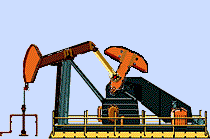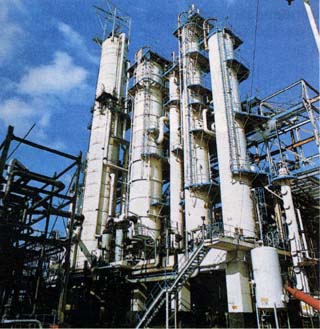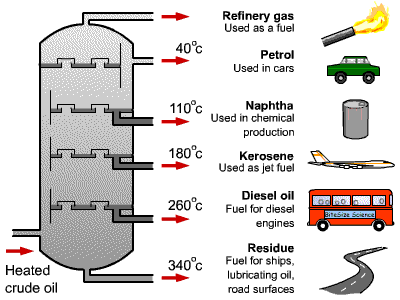|
The origin of oil or petroleum
is not well understood. There are several theories, but the matter is
still one of scientific controversy. It is generally accepted however
that the origin of oil begins with biological fossils, just as with coal
- but that they are the remains of sea creatures rather than trees. The
study of fossils is called paleontology. The study of the creation of
oil is part of geology.
 Oil is a mixture of liquid
hydrocarbons (chemical compounds containing only hydrogen and carbon)
plus various impurities such as sulphur. They can be separated out by
using the fact that they have different boiling points. This is done at
an oil refinery. (see below) Oil is a mixture of liquid
hydrocarbons (chemical compounds containing only hydrogen and carbon)
plus various impurities such as sulphur. They can be separated out by
using the fact that they have different boiling points. This is done at
an oil refinery. (see below)
 Unprocessed oil or petroleum
is usually called crude oil or mineral oil. The name petroleum (that petrol
comes from!) is from a combination of Latin words meaning "rock oil". Unprocessed oil or petroleum
is usually called crude oil or mineral oil. The name petroleum (that petrol
comes from!) is from a combination of Latin words meaning "rock oil".
 Oil may have a variety of appearances
and constitution. Some forms are black, others dark green, and some light
like kerosene. The liquid oils in the mixture that we call crude oil ranges
from very viscous to easy-flowing ones. Each oil constituent is a hydrocarbon
- they have varying molecular weights and differ from one another in structure
and properties. These various species are separated into groups, or fractions,
by a process of distillation called refining. Oil fuel, in all of its
usable forms, is a refined product, unlike coal
and natural gas which can often be burned in their
natural condition. Oil may have a variety of appearances
and constitution. Some forms are black, others dark green, and some light
like kerosene. The liquid oils in the mixture that we call crude oil ranges
from very viscous to easy-flowing ones. Each oil constituent is a hydrocarbon
- they have varying molecular weights and differ from one another in structure
and properties. These various species are separated into groups, or fractions,
by a process of distillation called refining. Oil fuel, in all of its
usable forms, is a refined product, unlike coal
and natural gas which can often be burned in their
natural condition.
 Oil has been known and used
since the most ancient times. It was used chiefly as a liniment or medicine,
not as a fuel. The Bible refers to pitch being used for building purposes
- cementing walls - in Babylon. Oil has been known and used
since the most ancient times. It was used chiefly as a liniment or medicine,
not as a fuel. The Bible refers to pitch being used for building purposes
- cementing walls - in Babylon.
 Oil
flows from natural springs in many localities. It was obtained from such
springs in what is now Western Pennsylvania by the Seneca Indians, who
used it for medicinal purposes. Drilling for oil was begun in the 1800s
and this is now the commonest way in which it is extracted. Oil
flows from natural springs in many localities. It was obtained from such
springs in what is now Western Pennsylvania by the Seneca Indians, who
used it for medicinal purposes. Drilling for oil was begun in the 1800s
and this is now the commonest way in which it is extracted.
 As a fuel, oil was originally
used as kerosene for lighting, replacing animal, vegetable and coal oils.
It also came to be used in furnaces. Its biggest use, however, came with
the development of the car. Today almost all forms of transport - cars,
lorries, buses, trains, ships and aeroplanes - are fueled by oil - mainly
diesel or petrol. Oil has also been burned to produce electricity in oil
fired power stations. As a fuel, oil was originally
used as kerosene for lighting, replacing animal, vegetable and coal oils.
It also came to be used in furnaces. Its biggest use, however, came with
the development of the car. Today almost all forms of transport - cars,
lorries, buses, trains, ships and aeroplanes - are fueled by oil - mainly
diesel or petrol. Oil has also been burned to produce electricity in oil
fired power stations.
Oil Refining
 When
crude oil arrives at an oil refinery it first undergoes a process of fractional
distillation (separating the mixture according to boiling point). The
crude oil is heated and piped into a large tower with perforated trays
welded to the walls every few feet. The heated vapours rise, cool and
condense at different levels (trays) in the tower. The lighter hydrocarbons
condense on the upper trays. In this way the crude is separated into fractions
or distillates. When
crude oil arrives at an oil refinery it first undergoes a process of fractional
distillation (separating the mixture according to boiling point). The
crude oil is heated and piped into a large tower with perforated trays
welded to the walls every few feet. The heated vapours rise, cool and
condense at different levels (trays) in the tower. The lighter hydrocarbons
condense on the upper trays. In this way the crude is separated into fractions
or distillates.

|




 Oil
Oil

 Oil
flows from natural springs in many localities. It was obtained from such
springs in what is now Western Pennsylvania by the Seneca Indians, who
used it for medicinal purposes. Drilling for oil was begun in the 1800s
and this is now the commonest way in which it is extracted.
Oil
flows from natural springs in many localities. It was obtained from such
springs in what is now Western Pennsylvania by the Seneca Indians, who
used it for medicinal purposes. Drilling for oil was begun in the 1800s
and this is now the commonest way in which it is extracted. When
crude oil arrives at an oil refinery it first undergoes a process of fractional
distillation (separating the mixture according to boiling point). The
crude oil is heated and piped into a large tower with perforated trays
welded to the walls every few feet. The heated vapours rise, cool and
condense at different levels (trays) in the tower. The lighter hydrocarbons
condense on the upper trays. In this way the crude is separated into fractions
or distillates.
When
crude oil arrives at an oil refinery it first undergoes a process of fractional
distillation (separating the mixture according to boiling point). The
crude oil is heated and piped into a large tower with perforated trays
welded to the walls every few feet. The heated vapours rise, cool and
condense at different levels (trays) in the tower. The lighter hydrocarbons
condense on the upper trays. In this way the crude is separated into fractions
or distillates. 

